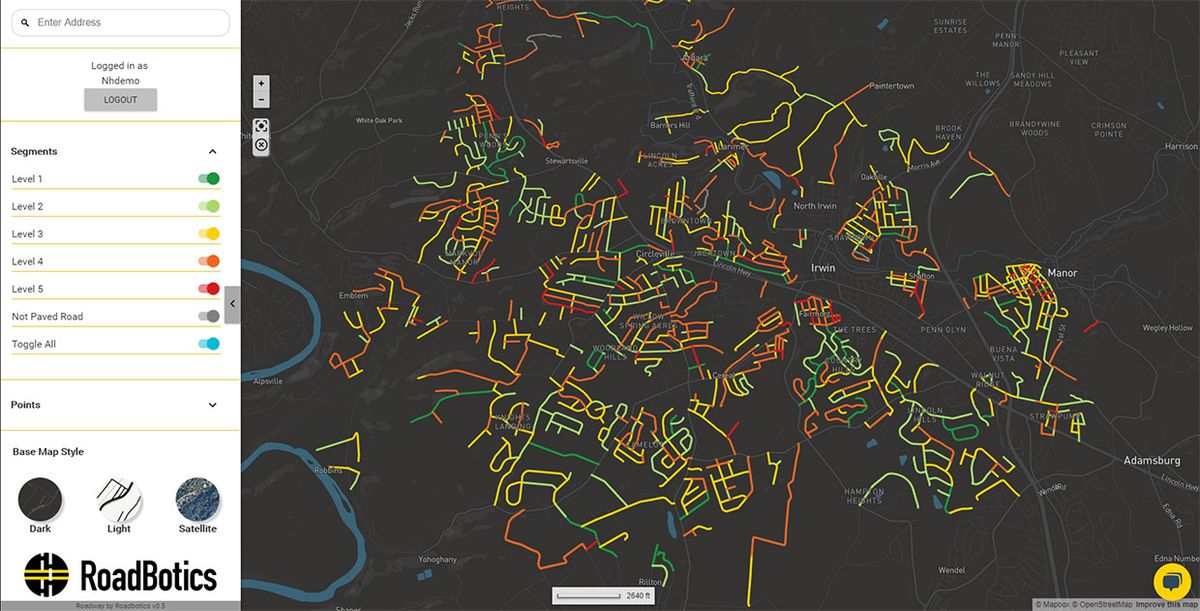’Tis the season for potholes. When temperatures drop, the expansion and contraction of water that seeps into cracks in asphalt can create giant tire-chompers. But these problem spots are too often the final result of damage that has been brewing for a while.
“There are things you can do 5 or even 10 years before that happens to push the lifespan of a road,” says Benjamin Schmidt, CTO of RoadBotics in Pittsburgh.
RoadBotics is using state-of-the-art computer-vision techniques to help local governments better manage roads. The company’s machine-learning algorithms process images of the road collected via smartphone. Then, it uses these images to produce an in-depth online map of road conditions that officials can use to make maintenance and repair decisions.
Since launching in December 2016, the Carnegie Mellon University spinoff has assessed roads for more than 90 cities, towns, and counties around the United States. Detroit will soon become the latest city to use RoadBotics’ technology to inspect its 4,200-kilometer (2,600-mile) network.
Roads are expensive to maintain. Asphalt takes a pounding from weather and traffic and cracks naturally over time. These cracks allow salts, fuel, and water to infiltrate and damage roads from underneath, and they can lead to larger problems that are more expensive to repair.
Cities and towns regularly assess their roads by sending out inspectors who drive around looking for signs of damage and manually recording type, extent, and location. This takes time, Schmidt says. “People get tired, or if you have multiple people assessing big road networks, they may not agree on conditions. We solve a lot of those problems with objective, quantitative data.”

RoadBotics offers road assessment as a service. The company sends out a vehicle—or the city could use its own service vehicles like garbage trucks or street sweepers—with a dashboard-mounted smartphone to drive every mile of a city’s network. Videos along with their GPS location are uploaded to a cloud server.
Then, the company’s AI algorithm uses deep-learning techniques to analyze each frame in the video, pixel by pixel. The company trains the neural networks by feeding them marked-up images of road surfaces where different colors correspond to different types of damage. RoadBotics says its AI can identity every useful aspect of the road surface as well as a human can, from giant potholes to more nuanced factors like bumps, depressions, and cracks.
The software creates a map of the road network with an overlay that shows each 3-meter stretch of road on a color-coded scale, with 1 (or green) being excellent to 5 (or red) meaning terrible and in need of repair. City officials can use the map to assess based on, say, conditions and usage, where best to spend their road-repair dollars.
This automated assessment saves time and money. The city of Savannah, Ga., for instance, had used 18 part-time interns to complete an assessment of its 1,100 kilometers of roads. The process took three years, cost US $130,000 and led to unreliable, poorly organized data. RoadBotics gave the city an objective road rating report in three months for a third of the cost. The affordability means that the city should be able to scan the network more regularly and identify small problems before they become large ones, according to Joe Shearouse in the Savannah City Manager's Office.
Roads might be just the start, Schmidt says. RoadBotics plans to use its AI technology to evaluate the condition of other transportation assets. “Power lines, signage, vegetation overgrowth, streetlights—all these things that need to be maintained are where we want to move our technology,” he says.
Prachi Patel is a freelance journalist based in Pittsburgh. She writes about energy, biotechnology, materials science, nanotechnology, and computing.



